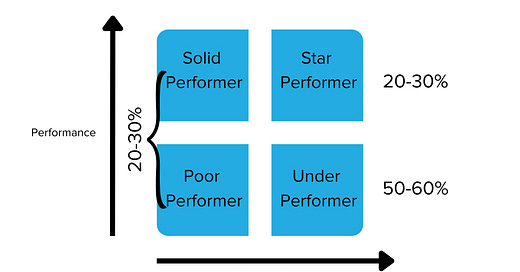Stop Coaching Everyone: Focus on the Ones Who Might Actually Change
Why Early Adopters and High-Potential Low-Skill Staff Deserve Your Best Coaching
Let’s talk about that teacher you keep rooting for — the one who lights up in planning meetings, asks thoughtful questions, and says,
“I tried it, and it kind of flopped, but I want to try again.”
They’re not your star performer — yet. But they care. They're trying. And they’re right on the edge of something good.
We call these folks bubble teachers — a nod to the “bubble students” we used to track for standardized test performance. They’re the ones with high potential and low current skill. They’re not struggling because they don’t care. They’re struggling because they’re still learning. And when you show up for them with real coaching, they don’t just improve — they transform.
Right beside them are your early adopters — the ones already testing out the new thing, tweaking it, and making it work before anyone else is even willing to try. They believe in change, even when it’s messy. They can pull others forward — if they feel supported.
If you’re serious about growth — for your school, your team, your students — these are the two groups who deserve your best coaching.
The ones who are ready, and the ones who are almost ready.
And yes, I’ve got data. But first, let me tell you about a school that meant well — and missed the mark.
The School That Tried to Coach Everyone (and Got Nowhere)
A couple years ago, I worked with a school where the admin team was committed to coaching every teacher equally. Every teacher got a 1:1 meeting every two weeks. Every walkthrough had a rubric. Every rubric had three glows and three grows.
No one was left out. No one was missed. It was... fair.
But it wasn’t working.
There was no buzz. No breakout classrooms. No visible momentum. Coaching felt like another compliance task — something you scheduled and endured, not something that changed you.
When we looked at the data and talked to teachers, the picture got clearer:
Early adopters felt stifled. The feedback was too generic.
Bubble teachers felt seen, but not stretched.
Resistors? Still resisting.
It wasn’t until we shifted our strategy — focusing more deeply on early adopters and bubble teachers — that things started to move. We celebrated risk-taking. We coached through the mess. And we started hearing phrases like:
“I saw what Ms. Nguyen did — can you help me try something like that?”
Momentum was born not from coaching everyone — but from coaching the right people at the right time.
Of Course, There’s a Matrix
The performance-potential matrix is a tool leaders often use to think about where people are now and where they could go.
Performance = how well someone is currently doing in their role.
Potential = their capacity to grow, take on more responsibility, or lead future work.
Here’s what the quadrants mean:
High Performance, High Potential Star Performer — your future leaders and go-to examples.
High Performance, Low Potential Solid Performer — reliable, effective, steady.
Low Performance, High Potential “Bubble Teacher” / Under Performer — still developing but full of promise.
Low Performance, Low Potential Poor Performer — struggling and likely misaligned.
So, what’s up with the percentages?
These are general estimates based on research and leadership theory — they’re not rigid rules, but they do reflect typical patterns in most organizations:
Poor and Solid Performers together take up 20–30% of your time. Don’t waste time in places where things won’t move.
Under Performers make up 50–60% of your coaching capacity - the bubble teachers.
Star Performers represent 20-30% of your team - the early adopters.
It’s tempting to spread coaching evenly or focus on the loudest resistors. But that rarely builds momentum. The better move? Focus where growth is most likely.
Use the matrix not as a sorting hat, but as a compass — guiding your time toward people who are most ready to grow.
Because potential isn’t a compliment. It’s a challenge. A quiet dare to believe in someone — not just for who they are now, but for who they might become.
The Bell Curve (and Why You Should Care)
Now let’s zoom out and look at how change actually spreads.
Early adopters are your spark.
Bubble teachers are your kindling.
The rest of your staff is watching to see who catches fire.
When early adopters get real support — not just a quick drive-by but deep, stretch-your-thinking coaching — they grow in public. That gives bubble teachers permission to try. It shifts the hallway chatter from “Ugh, another thing” to “Okay... I think I could pull that off.”
You don’t need everyone to jump on board. You just need a few people to light the way.
What This Looks Like in Real Life
Prioritize 3–5 early adopters and bubble teachers for weekly coaching cycles.
Celebrate their risks — loudly and often.
Ask deeper questions. Don’t just affirm their effort — help them level up.
Turn their wins into stories other staff can see, feel, and believe.
Stop doing shallow drive-bys with everyone else just to “check the box.”
This isn’t about favoritism. It’s about intentional momentum-building.
What’s At Stake
Teachers are trying. They’re tired, but they’re still showing up.
When a bubble teacher gets your best coaching, they start to believe something powerful:
I can get better. I belong here.
When an early adopter feels supported, they don’t burn out from always carrying the torch. They become champions who spark others.
And when those stories ripple across a staff, even the most skeptical teachers start to wonder,
What if that could be me?
Because every teacher deserves to grow.
But some need your best coaching to become the proof that change is possible.






Exactly what I needed to read today. Thanks!